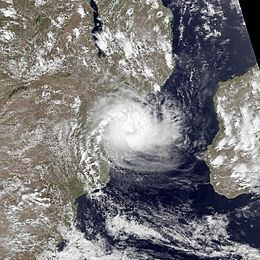Formed February 24, 1997 Areas affected Mozambique Fatalities 87 | Dissipated March 3, 1997 Affected area Mozambique | |
 | ||
Highest winds 10-minute sustained: 95 km/h (60 mph)
1-minute sustained: 140 km/h (85 mph) Lowest pressure 980 hPa (mbar); 28.94 inHg Date 24 February 1997 – 3 March 1997 | ||
Tropical Storm Lisette was the final named storm of the moderately active 1996–97 South-West Indian Ocean cyclone season. On February 24, a tropical disturbance developed. It slowly intensified while located near the coast of Mozambique, and after briefly moving ashore, it became a moderate tropical storm. Lisette subsequently moved south and continued to deepen. On February 27, Lisette abruptly turned west, though the storm's motion remain slow. After showing hints of the development of an eye, Tropical Storm Lisette attained peak intensity as a severe tropical storm on February 28. Thereafter, intensification stopped, likely due to increased wind shear. Even though Lisette began to show signs of intensification on March 1, it did not intensify further and moved ashore that day at peak intensity. The remnants were last seen over Central Africa two days later. Affecting a country already inundated by Cyclone Josie earlier in the year, Lisette brought additional flooding to the nation. The Nampula Province in Mozambique was severely damaged by the storm, where many roads were damaged. Effects from the system spread as far north as northern Mozambique. Overall, 87 people died while 80,000 others were directly affected.
Contents
Meteorological history
Throughout the month of February, tropical cyclogenesis was quite common over the southern Indian Ocean. On February 24, following decreased pressures across the northern Mozambique channel, the Intertropical Convergence Zone (ITCZ) spawned a tropical wave. An atmospheric circulation began to subsequently develop along the wave axis as it was centered just offshore the Mozambique coast. Situated in an environment with warm sea surface temperatures, the system was first classified by the Météo-France office on Réunion (MFR) late on February 24, though the JTWC did not start watching the system until the next day, when it was located slightly onshore Mozambique. The following day, MFR upgraded the system into a tropical depression while located within 100 km (60 mi) of the coast of Mozambique. The system slowly became better organized as the storm drifting generally south and by 0000 UTC on February 27, the JTWC estimated that Lisette attained gale-force winds. That night, the storm developed a central dense overcast, a large mass of deep convection, and was thus upgraded into a moderate tropical storm while located halfway between Mozambique and Madagascar. By this time, intensity estimates from the JTWC indicated that the storm had attained hurricane-equivalent status.
Following the movement of a trough, Lisette abruptly turned west, though the storm's motion remained slow. Meanwhile, Lisette began to deepen, and by that evening, the storm began to develop an eye. Based on this, MFR upgraded the storm into a severe tropical storm. At this time, the storm attained its peak intensity of 95 km/h (60 mph), although JTWC data indicates that Cyclone Lisette was significantly stronger, with winds of 130 km/h (80 mph), making Lisette a moderate Category 1 hurricane on the Saffir-Simpson Hurricane Wind Scale. However, early on March 1, the storm leveled off in intensity for no known reason, though it has been theorized that this was due to an increase wind shear. After maintaining its intensity for a day, it began to approach the coast of Mozambique and thus began to show hints of additional development due a sudden decrease in shear. According to the JTWC, the storm peaked in intensity with winds of 140 km/h (85 mph). However, MFR suggests that the storm did not intensify prior to landfall on March 1. Although the JTWC stopped monitoring the system the subsequent day, MFR tracked this system until March 3, when it was located over Zimbabwe, ending the above-average season.
Impact and aftermath
Facing a region already inundated by Cyclone Josie less than a month prior, Lisette was also the fourth tropical cyclone observed in the Mozambique Channel that season, thought it was the only storm of the year to strike Mozambique. Tropical Storm Lisette brought additional flooding to the nation. Most of the south-central Mozambique was drenched with rainfall totals ranging from 60 mm (2.4 in) to 200 mm (7.9 in), setting numerous records. Due to the precursor disturbance of Lisette, the Nampula Province in Mozambique was severely flooded by the storm, severely damaging several roads, though two of the roads were eventually repaired. The Sofala and Inhambane Provinces were also badly affected by the system; widespread flooding spread as far north as northern Mozambique.
Due to the storm, many sooty terns (Onychoprion fuscatus) were swept inland from the coast for only the second time in recorded history. Overall, 87 people perished in the cyclone while 80,000 others were directly affected. Several years after the passage of the system, an appeal was launched for money from the Government of South Africa, asking them to pay for the damaged roads, but because the road was built by a private company, the appeal was denied.
